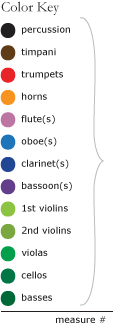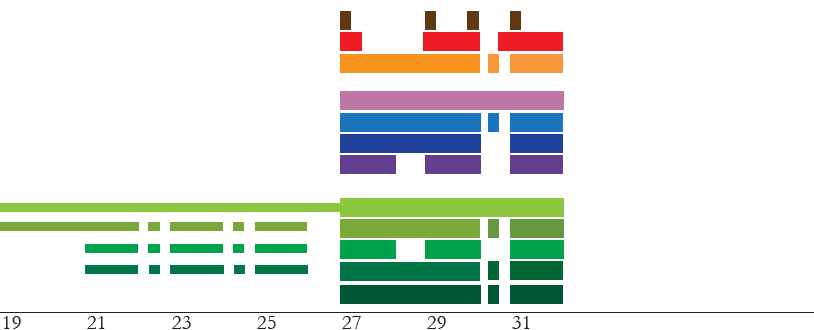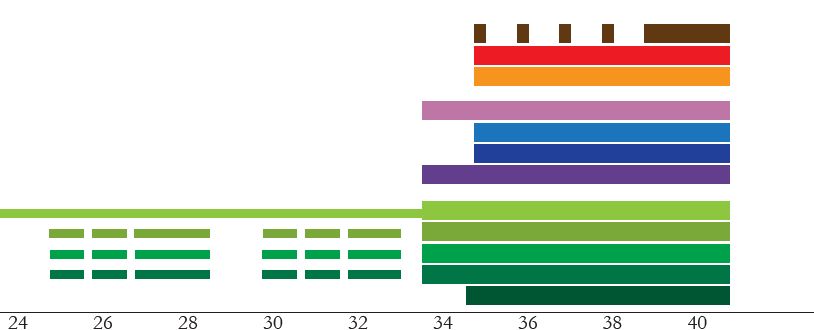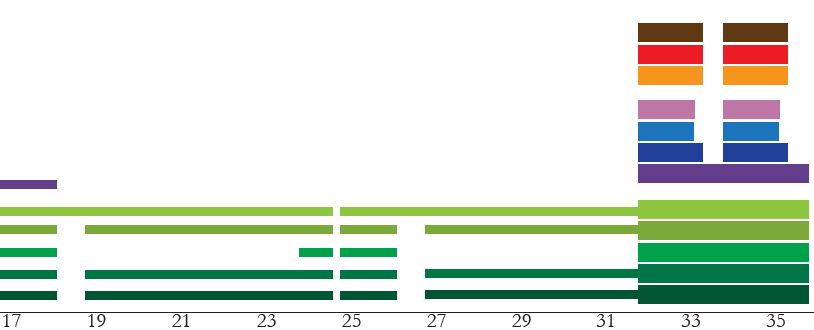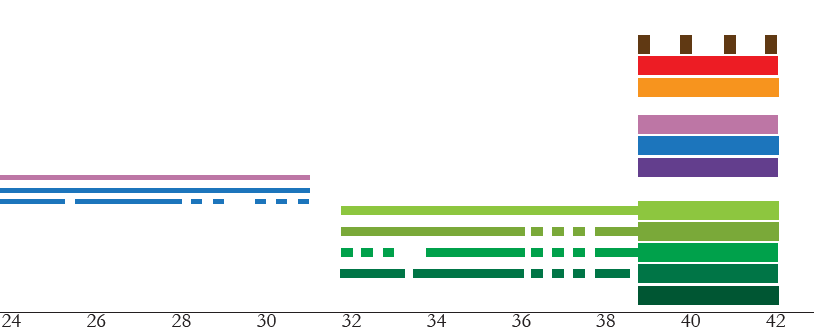Orchestral Graphs
These graphs represent various musical passages and movements in terms of their orchestration; they are tools for shifting our focus from pitch and harmony towards instrumental texture and effect. They are included in the book in black and white; this website presents them in color, which is clearer and more vivid.
Colors are used to represent the instruments of the orchestra: strings are different shades of green, while the winds are a variety of colors. Line thickness reflects dynamics: the louder the volume, the thicker the line. The color scheme is a nod to one aspect of eighteenth-century associations of instruments and colors, namely the notion that strings were more uniform and while wind instruments were more variegated. The specific colors chosen loosely reflect some instrument-color associations (such as scarlet trumpets), but were determined first and foremost by design and legibility.
- Fig. 3.1 Orchestral graph of Haydn, Symphony No. 99 in E-flat major, movement I, mm. 19–31.
- Fig. 3.2 Orchestral graph of Haydn, Symphony No. 101 in D major, movement I, mm. 19–31.
- Fig. 3.3 Orchestral graph of Haydn, Symphony No. 104 in D major, movement I, mm. 17–35.
- Fig. 3.4 Orchestral graph of Haydn, Symphony No. 100 in G major, “Military,” movement I, mm. 24–42.
- Fig. 3.5 Orchestral graphs of the slow movements from Haydn, Symphonies Nos. 88, 94, 100, and 101.
- Fig. 3.6 Orchestral graphs of the slow movements from Mozart, Symphonies Nos. 38, 39, 40, and 41.
Fig. 3.1 Orchestral graph of Haydn, Symphony No. 99 in E-flat major, movement I, mm. 19–31.
(Click chart to enlarge.)
Fig. 3.2 Orchestral graph of Haydn, Symphony No. 101 in D major, movement I, mm. 19–31.
(Click chart to enlarge.)
Fig. 3.3 Orchestral graph of Haydn, Symphony No. 104 in D major, movement I, mm. 17–35.
(Click chart to enlarge.)
Fig. 3.4 Orchestral graph of Haydn, Symphony No. 100 in G major, “Military,” movement I, mm. 24–42.
(Click chart to enlarge.)
Fig. 3.5 Orchestral graphs of the slow movements from Haydn, Symphonies Nos. 88, 94, 100, and 101.
Haydn, Symphony No. 88 in G major, Movement II, mm. 1-114
(Click chart to enlarge.)
Haydn, Symphony No. 94 in G major (“Surprise”), Movement II, mm. 1-156
(Click chart to enlarge.)
Haydn, Symphony No. 100 in G major (“Military”), Movement II (complete)
(Click chart to enlarge.)
Haydn, Symphony No. 101 in D major (“Clock”), Movement II, mm. 1-150
(Click chart to enlarge.)
Fig. 3.6 Orchestral graphs of the slow movements from Mozart, Symphonies Nos. 38, 39, 40, and 41.
Mozart, Symphony No. 38 in D major (“Prague”), Movement II
(Click chart to enlarge.)
Mozart, Symphony No. 39 in E-flat major, Movement II
(Click chart to enlarge.)
Mozart, Symphony No. 40 in G minor, Movement II
(Click chart to enlarge.)
Mozart, Symphony No. 41 in C major (“Jupiter”), Movement II
(Click chart to enlarge.)
These graphs were created by hand using Adobe Illustrator. Many thanks to David Miller, who painstakingly helped create these.













